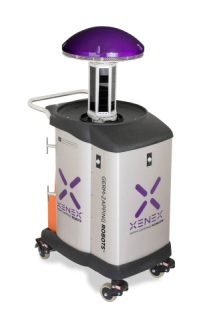Feb 23 2015
Standing 5 feet 2 inches tall, William Beaumont Army Medical Center’s newest staff asset doesn’t initially have a commanding presence. It is the L-Vira Xenex Germ-Zapping Robot. However, after five minutes, its impact has the potential to save countless lives around the world.
 The Xenex germ-zapping robot has been deployed to fight germs at Fort Bliss in the William Beaumont Army Medical Center. (Photo: Business Wire)
The Xenex germ-zapping robot has been deployed to fight germs at Fort Bliss in the William Beaumont Army Medical Center. (Photo: Business Wire)
The infectious disease section received a germ-zapping robot that employs the power of technology to destroy viruses – including the Ebola virus. The robot’s pulsed xenon ultraviolet (UV) light, which is 25,000 times more intense than sunlight, is used to disinfect a variety of rooms and spaces at William Beaumont. No one can be in the room while the robot is in use but this germ-zapping machine and its technology is safe for patients and equipment.
“William Beaumont is the first El Paso hospital to acquire this robot for disease containment and Ebola virus preparedness,” said Lynn McNicol, RN, infection preventionist. “This germ-zapping robot provides an extra measure of safety for both our patients and our intensive care unit staff.”
Xenex offers the fastest, safest, and most cost-effective method for the disinfection of healthcare facilities, such as patient rooms, operating rooms and intensive care units. Xenex robots quickly destroy the microorganisms that cause healthcare associated infections (HAI), such as Clostridium difficile (C.diff), Methicillin-resistant Staphylococcus aureus (MRSA) and the Ebola virus. The Xenex germ-zapping robot works by pulsing xenon, an inert gas, at high intensity in a xenon ultraviolet flash lamp. This produces ultraviolet C (UVC), which penetrates the cell walls of microorganisms including bacteria, viruses, mold, fungus and spores. Their DNA is instantly fused so that they are unable to reproduce or mutate, effectively killing them on surfaces and in the air without contact or chemicals.